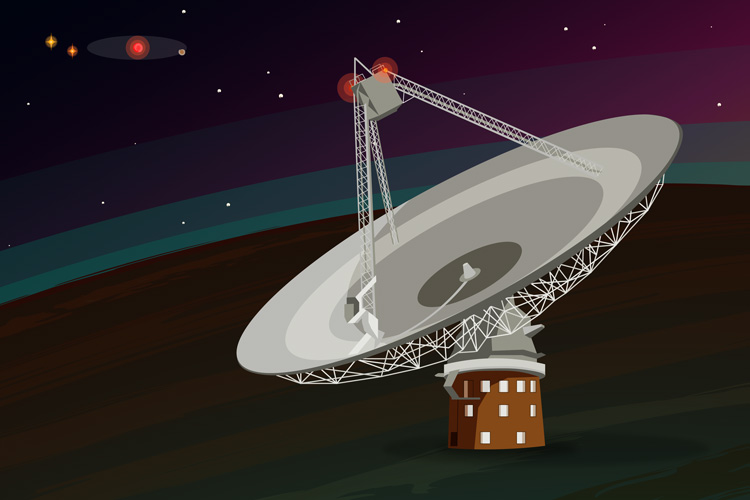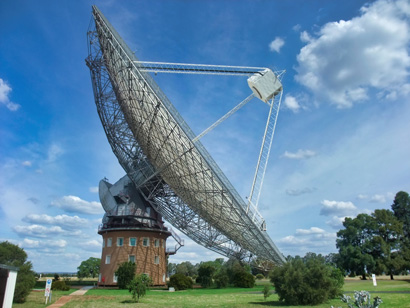When ET Calls, Can We Be Sure We’re Not Being Spoofed?

Scientists have devised a new technique for finding and vetting possible radio signals from other civilizations in our galaxy — a major advance in the search for extraterrestrial intelligence (SETI) that will significantly boost confidence in any future detection of alien life.
Most of today’s SETI searches are conducted by Earth-based radio telescopes, which means that any ground or satellite radio interference — ranging from Starlink satellites to cellphones, microwaves and even car engines — can produce a radio blip that mimics a technosignature of a civilization outside our solar system. Such false alarms have raised and then dashed hopes since the first dedicated SETI program began in 1960.
Currently, researchers vet these signals by pointing the telescope in a different place in the sky, then return a few times to the spot where the signal was originally detected to confirm it wasn’t a one-off. Even then, the signal could be something weird produced on Earth.
The new technique, developed by researchers at the Breakthrough Listen project at the University of California, Berkeley, checks for evidence that the signal has actually passed through interstellar space, eliminating the possibility that the signal is mere radio interference from Earth.
Breakthrough Listen, the most comprehensive SETI search anywhere, monitors the northern and southern skies with radio telescopes in search of technosignatures. It also targets thousands of individual stars in the plane of the Milky Way galaxy, which is the likely direction a civilization would beam a signal, with a particular focus on the center of the galaxy.
“I think it’s one of the biggest advances in radio SETI in a long time,” said Andrew Siemion, principal investigator for Breakthrough Listen and director of the Berkeley SETI Research Center (BSRC), which operates the world’s longest running SETI program. “It’s the first time where we have a technique that, if we just have one signal, potentially could allow us to intrinsically differentiate it from radio frequency interference. That’s pretty amazing, because if you consider something like the Wow! signal, these are often a one-off.”

Scientists have devised a new technique for finding and vetting possible radio signals from other civilizations in our galaxy — a major advance in the search for extraterrestrial intelligence (SETI) that will significantly boost confidence in any future detection of alien life.
Most of today’s SETI searches are conducted by Earth-based radio telescopes, which means that any ground or satellite radio interference — ranging from Starlink satellites to cellphones, microwaves and even car engines — can produce a radio blip that mimics a technosignature of a civilization outside our solar system. Such false alarms have raised and then dashed hopes since the first dedicated SETI program began in 1960.
Currently, researchers vet these signals by pointing the telescope in a different place in the sky, then return a few times to the spot where the signal was originally detected to confirm it wasn’t a one-off. Even then, the signal could be something weird produced on Earth.
The new technique, developed by researchers at the Breakthrough Listen project at the University of California, Berkeley, checks for evidence that the signal has actually passed through interstellar space, eliminating the possibility that the signal is mere radio interference from Earth.
Breakthrough Listen, the most comprehensive SETI search anywhere, monitors the northern and southern skies with radio telescopes in search of technosignatures. It also targets thousands of individual stars in the plane of the Milky Way galaxy, which is the likely direction a civilization would beam a signal, with a particular focus on the center of the galaxy.
“I think it’s one of the biggest advances in radio SETI in a long time,” said Andrew Siemion, principal investigator for Breakthrough Listen and director of the Berkeley SETI Research Center (BSRC), which operates the world’s longest running SETI program. “It’s the first time where we have a technique that, if we just have one signal, potentially could allow us to intrinsically differentiate it from radio frequency interference. That’s pretty amazing, because if you consider something like the Wow! signal, these are often a one-off.”

Because of the huge background of narrowband radio bursts from human activity on Earth, finding a signal from outer space is like looking for a needle in a haystack. So far, no narrowband radio signals from outside our solar system have been confirmed, though Breakthrough Listen found one interesting candidate — dubbed BLC1 — in 2020. Later analysis determined that it was almost certainly due to radio interference, Siemion said.
Siemion and his colleagues realized, however, that real signals from extraterrestrial civilizations should exhibit features caused by passage through the ISM that could help discriminate between Earth- and space-based radio signals. Thanks to past research describing how the cold plasma in the interstellar medium, primarily free electrons, affect signals from radio sources such as pulsars, astronomers now have a good idea how the ISM affects narrowband radio signals. Such signals tend to rise and fall in amplitude over time — that is, they scintillate. This is because the signals are slightly refracted, or bent, by the intervening cold plasma, so that when the radio waves eventually reach Earth by different paths, the waves interfere, both positively and negatively.
Our atmosphere produces a similar scintillation, or twinkle, that affects the pinprick of optical light from a star. Planets, which are not point sources of light, do not twinkle.
Brzycki developed a computer algorithm, available as a Python script, that analyzes the scintillation of narrowband signals and plucks out those that dim and brighten over periods of less than a minute, indicating they’ve passed through the ISM.
“This implies that we could use a suitably tuned pipeline to unambiguously identify artificial emission from distant sources vis-a-vis terrestrial interference,” de Pater said. “Further, even if we didn’t use this technique to find a signal, this technique could, in certain cases, confirm a signal originating from a distant source, rather than locally. This work represents the first new method of signal confirmation beyond the spatial reobservation filter in the history of radio SETI.”

Brzycki is now conducting radio observations at the Green Bank Telescope in West Virginia to show that the technique can quickly weed out Earth-based radio signals and perhaps even detect scintillation in a narrowband signal — a technosignature candidate.
“Maybe we can identify this effect within individual observations and see that attenuation and brightening and actually say that the signal is undergoing that effect,” he said. “It’s another tool that we have available now.”
The technique will be useful only for signals that originate more than about 10,000 light years from Earth, since a signal must travel through enough of the ISM to exhibit detectable scintillation. Anything originating nearby — the BLC-1 signal, for example, seemed to be coming from our nearest star, Proxima Centauri — would not exhibit this effect.
Other co-authors of the paper are James Cordes of Cornell, Brian Lacki of BSRC and Vishal Gajjar and Sofia Sheikh of both BSRC and the SETI Institute. Breakthrough Listen is managed by the Breakthrough Initiatives, a program sponsored by the Breakthrough Prize Foundation.
RELATED INFORMATION
- On Detecting Interstellar Scintillation in Narrowband Radio SETI (ApJ)
- Berkeley SETI Research Center and Breakthrough Listen
- Breakthrough Initiatives
- Artificial intelligence joins search for extraterrestrial intelligence (January 2023)
- Internet investor Yuri Milner joins with Berkeley in $100 million search for extraterrestrial intelligence (2015)
